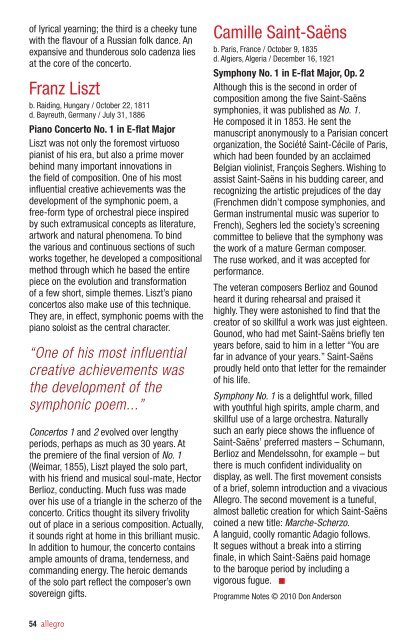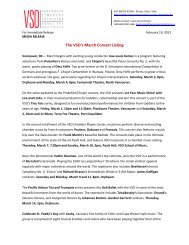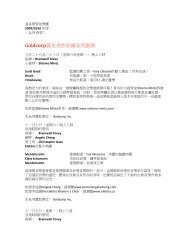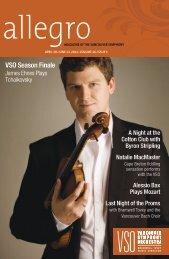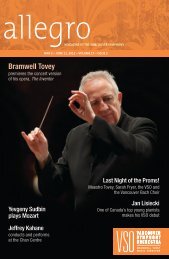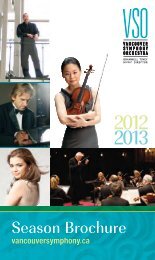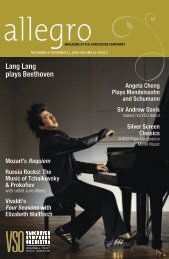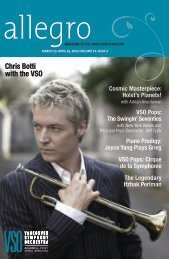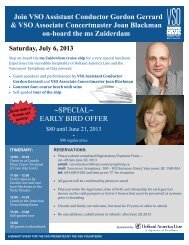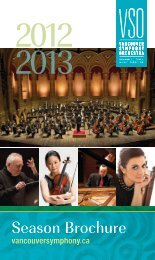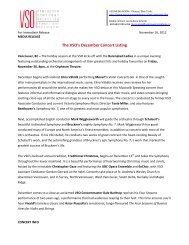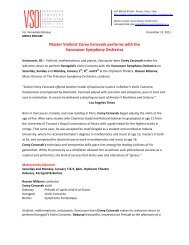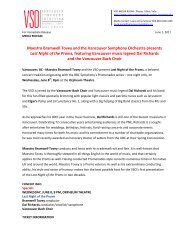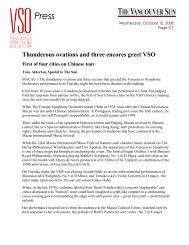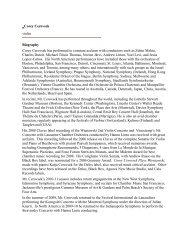issue one - Vancouver Symphony Orchestra
issue one - Vancouver Symphony Orchestra
issue one - Vancouver Symphony Orchestra
Create successful ePaper yourself
Turn your PDF publications into a flip-book with our unique Google optimized e-Paper software.
of lyrical yearning; the third is a cheeky tune<br />
with the flavour of a Russian folk dance. An<br />
expansive and thunderous solo cadenza lies<br />
at the core of the concerto.<br />
Franz Liszt<br />
b. Raiding, Hungary / October 22, 1811<br />
d. Bayreuth, Germany / July 31, 1886<br />
Piano Concerto No. 1 in E-flat Major<br />
Liszt was not only the foremost virtuoso<br />
pianist of his era, but also a prime mover<br />
behind many important innovations in<br />
the field of composition. One of his most<br />
influential creative achievements was the<br />
development of the symphonic poem, a<br />
free-form type of orchestral piece inspired<br />
by such extramusical concepts as literature,<br />
artwork and natural phenomena. To bind<br />
the various and continuous sections of such<br />
works together, he developed a compositional<br />
method through which he based the entire<br />
piece on the evolution and transformation<br />
of a few short, simple themes. Liszt’s piano<br />
concertos also make use of this technique.<br />
They are, in effect, symphonic poems with the<br />
piano soloist as the central character.<br />
“One of his most influential<br />
creative achievements was<br />
the development of the<br />
symphonic poem...”<br />
Concertos 1 and 2 evolved over lengthy<br />
periods, perhaps as much as 30 years. At<br />
the premiere of the final version of No. 1<br />
(Weimar, 1855), Liszt played the solo part,<br />
with his friend and musical soul-mate, Hector<br />
Berlioz, conducting. Much fuss was made<br />
over his use of a triangle in the scherzo of the<br />
concerto. Critics thought its silvery frivolity<br />
out of place in a serious composition. Actually,<br />
it sounds right at home in this brilliant music.<br />
In addition to humour, the concerto contains<br />
ample amounts of drama, tenderness, and<br />
commanding energy. The heroic demands<br />
of the solo part reflect the composer’s own<br />
sovereign gifts.<br />
Camille Saint-Saëns<br />
b. Paris, France / October 9, 1835<br />
d. Algiers, Algeria / December 16, 1921<br />
<strong>Symphony</strong> No. 1 in E-flat Major, Op. 2<br />
Although this is the second in order of<br />
composition among the five Saint-Saëns<br />
symphonies, it was published as No. 1.<br />
He composed it in 1853. He sent the<br />
manuscript anonymously to a Parisian concert<br />
organization, the Société Saint-Cécile of Paris,<br />
which had been founded by an acclaimed<br />
Belgian violinist, François Seghers. Wishing to<br />
assist Saint-Saëns in his budding career, and<br />
recognizing the artistic prejudices of the day<br />
(Frenchmen didn’t compose symphonies, and<br />
German instrumental music was superior to<br />
French), Seghers led the society’s screening<br />
committee to believe that the symphony was<br />
the work of a mature German composer.<br />
The ruse worked, and it was accepted for<br />
performance.<br />
The veteran composers Berlioz and Gounod<br />
heard it during rehearsal and praised it<br />
highly. They were astonished to find that the<br />
creator of so skillful a work was just eighteen.<br />
Gounod, who had met Saint-Saëns briefly ten<br />
years before, said to him in a letter “You are<br />
far in advance of your years.” Saint-Saëns<br />
proudly held onto that letter for the remainder<br />
of his life.<br />
<strong>Symphony</strong> No. 1 is a delightful work, filled<br />
with youthful high spirits, ample charm, and<br />
skillful use of a large orchestra. Naturally<br />
such an early piece shows the influence of<br />
Saint-Saëns’ preferred masters – Schumann,<br />
Berlioz and Mendelssohn, for example – but<br />
there is much confident individuality on<br />
display, as well. The first movement consists<br />
of a brief, solemn introduction and a vivacious<br />
Allegro. The second movement is a tuneful,<br />
almost balletic creation for which Saint-Saëns<br />
coined a new title: Marche-Scherzo.<br />
A languid, coolly romantic Adagio follows.<br />
It segues without a break into a stirring<br />
finale, in which Saint-Saëns paid homage<br />
to the baroque period by including a<br />
vigorous fugue. ■<br />
Programme Notes © 2010 Don Anderson<br />
54 allegro


